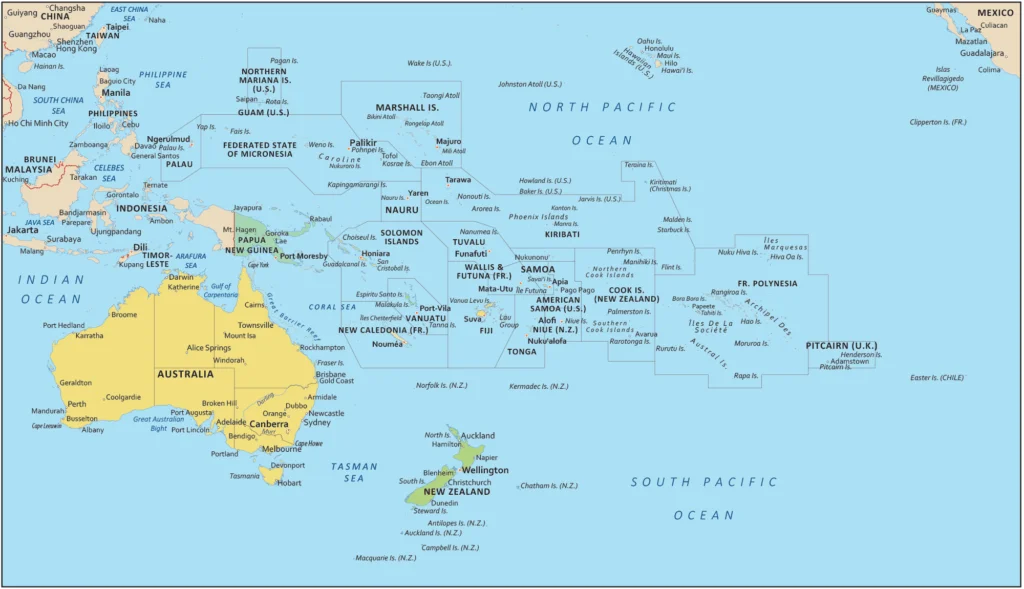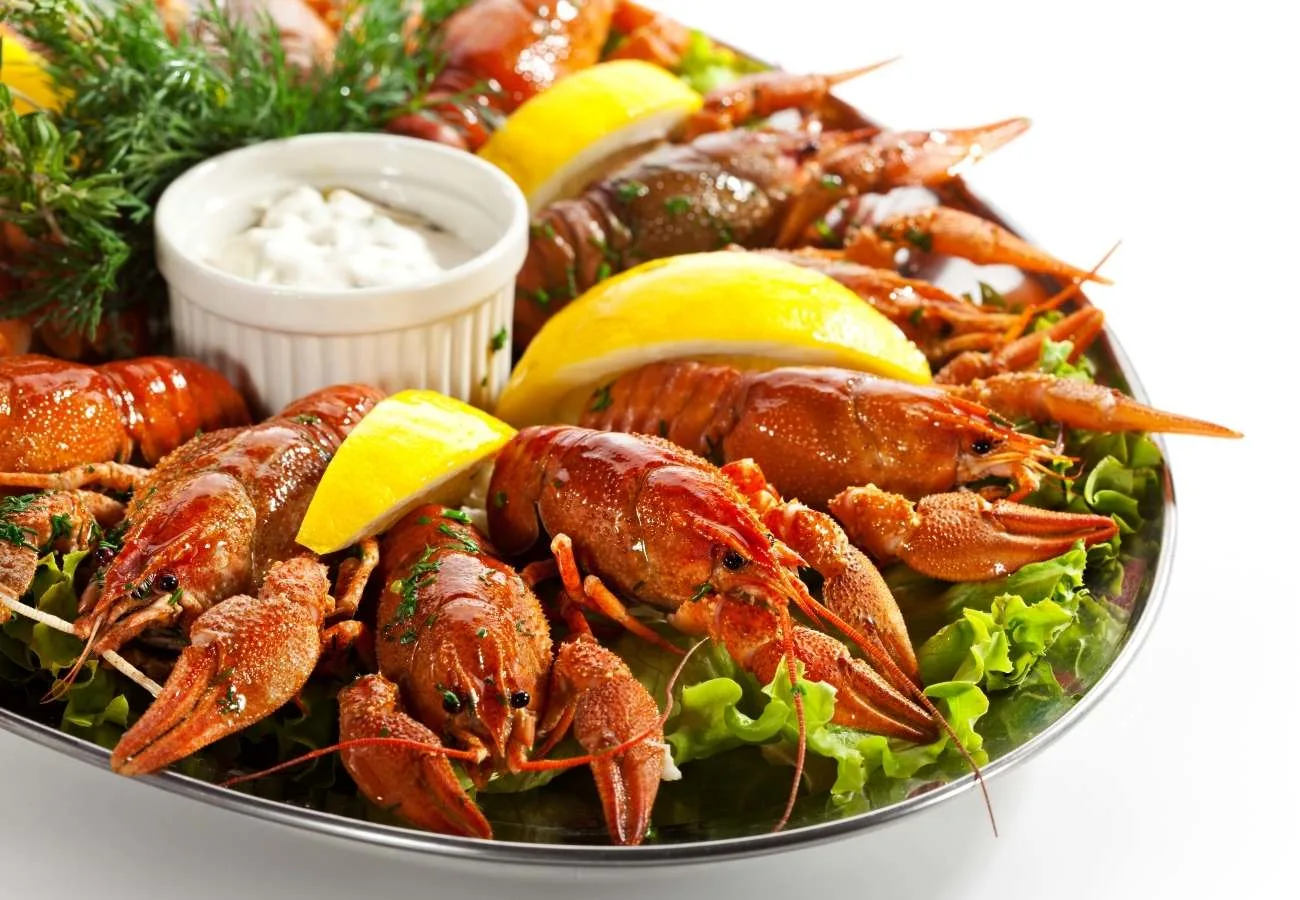The vast Pacific Ocean is home to an incredibly diverse culinary region known as Oceania. Comprising the many island nations and territories scattered across this expanse of blue. Oceania Cooking is as rich and varied as its marine life.
This article will take you on a journey through the flavors and traditions that define Oceania cooking. We explore everything from its defining characteristics to its global influence.
The Countries that Make Up Oceania Cooking

Oceania, often interchanged with the term “Oceania,” encompasses a broad spectrum of countries, including
- Australia
- New Zealand
- Papua New Guinea
the Pacific Islands grouped into three sub-regions:
- Melanesia
- Micronesia
- Polynesia.
This includes countries such as Fiji, Samoa, Tonga, the Solomon Islands, Vanuatu, and beyond.
Each of these nations brings its unique taste to the Oceana culinary table. Indigenous traditions, colonial pasts, and the bounty of their natural environment influence it.
Oceania cooking French Crepes

History and Background:
Oceania, with its diverse cultures and culinary influences, has embraced the art of French crepes in its own unique way. The fusion of French cooking techniques with local ingredients results in a delightful blend of flavors, making Oceania’s take on crepes distinctive and flavorful.
Ingredients:
For the Crepe Batter:
- 1 cup all-purpose flour
- 2 large eggs
- 1 cup milk
- 1/4 teaspoon salt
- 2 tablespoons melted butter
For Filling and Toppings (Customizable to Regional Flavors):
- Fresh tropical fruits (such as mango, pineapple, or passion fruit)
- Coconut cream or coconut milk
- Local honey or syrup
- Shredded coconut
- Macadamia nuts, crushed
- Whipped cream or yogurt (optional)
Recipe:
1. Prepare the Crepe Batter:
- In a mixing bowl, whisk together the flour and eggs until well combined.
- Gradually add the milk, whisking continuously to avoid lumps.
- Incorporate the melted butter and salt, continuing to whisk until the batter is smooth.
- Let the batter rest for at least 30 minutes to allow the flour to absorb the liquid.
2. Cook the Crepes:
- Heat a non-stick skillet or crepe pan over medium heat.
- Lightly grease the pan with butter or oil.
- Pour a small amount of batter into the center of the pan, swirling it to spread evenly.
- Cook for about 1-2 minutes on each side, or until the edges are golden brown.
- Repeat until all the batter is used, stacking the crepes on a plate.
3. Prepare the Filling:
- Slice the tropical fruits into bite-sized pieces.
- In a separate bowl, mix coconut cream or coconut milk with a touch of local honey or syrup.
- Set out additional toppings like shredded coconut and crushed macadamia nuts.
4. Assemble the Crepes:
- Lay a crepe flat on a plate.
- Spoon a generous amount of the coconut cream mixture onto the center of the crepe.
- Add a variety of tropical fruits and any other desired toppings.
- Fold or roll the crepe, enclosing the filling.
5. Serve and Enjoy:
- Repeat the process for additional crepes.
- Serve the Oceania-inspired French crepes with an extra drizzle of coconut cream or a dollop of whipped cream if desired.
- Garnish with additional shredded coconut or crushed macadamia nuts.
This Oceania-inspired French crepe recipe allows for creativity, letting you customize the filling with locally available ingredients. The result is a delightful dish that harmonizes the elegance of French crepes with the tropical and diverse flavors of Oceania.
Oceania Cuisine
Oceania cuisine is a diverse and vibrant culinary tradition that reflects the rich cultural heritage of the Pacific Islands. Known for its emphasis on fresh seafood, tropical fruits, and unique cooking techniques, Oceania cuisine offers a delightful fusion of flavors and ingredients.
From the traditional Polynesian dishes to the modern twists of Australian and New Zealand cuisine, there is something to satisfy every palate in Oceania.
The Main Characteristics of Oceania cooking
Oceania cooking is characterized by its reliance on fresh, local ingredients, traditional methods, and the blending of flavors from both the land and sea.
Methods like the earth oven, or ‘umu’ in Polynesia, ‘lovo’ in Fiji, and ‘mumu’ in Papua New Guinea, involve slow-cooking food wrapped in banana leaves underground, imparting a smoky, tender quality to the food.
Another characteristic is the harmonious balance in meals. These often feature a protein source from the sea, a starch (such as taro or sweet potato). It also features a fresh fruit or vegetable; coconut is a staple across many dishes.
The flavors are generally straightforward but profound, often accentuated with tropical fruits like mango, pineapple, and guava.
The Geographic and Climate Features that Have Influenced Oceania Cooking

The islands of Oceania are blessed with fertile soil, abundant seas, and climates that range from the tropical to temperate. This diversity has resulted in a plethora of ingredients that have become central to local diets. The warm waters are teeming with fish, shellfish, and other seafood, which is a staple of the Oceanic diet.
The climate also supports the growth of a wide array of produce. For example, taro thrives in the wetter parts of the Pacific, while breadfruit and yams are common in slightly drier areas.
These staples have shaped the Oceanic palate and culinary practices, with each community developing ways to cultivate and cook these ingredients best suited to their environment.
The Main Ingredients that are Used in Oceania Recipes
Staple ingredients in Oceania cooking include seafood, root vegetables (such as taro, yams, and sweet potatoes), tropical fruits, and coconut in various forms (milk, cream, oil, and flesh).
Sago, a starch derived from palm trees, is also prominent, particularly in Papua New Guinea. Meats, predominantly pork and chicken, are reserved for more ceremonial or festive occasions.
The usage of ingredients often depends on their availability, which in turn is dictated by the seasons and the geography of the island.
How Healthy is Oceania Cooking
Oceania cooking is considered relatively healthy due to its emphasis on fresh, whole foods, and minimal use of processed ingredients. Traditional diets are high in fiber, vitamins, and minerals from the array of fruits and vegetables consumed, and the use of fresh seafood provides a good source of lean protein and omega-3 fatty acids.
However, the shift towards more Western-style diets has introduced health issues in some Oceanic countries. To counteract this, there’s a growing movement within these nations to return to the roots of traditional diets, focusing on local and sustainable eating practices.
How Oceania Recipes Have Spread Through the Rest of the World
The globalization of food has led to the spread of Oceania recipes across the globe. Pacific Island food festivals, the diaspora of Oceanic peoples, and the popularity of Hawaiian poke bowls have introduced the world to the flavors of the Pacific.
Chefs from Australia and New Zealand have also played a significant role in putting Oceania cuisine on the global culinary map, showcasing indigenous ingredients and traditional methods in fine dining establishments worldwide.
Furthermore, the growing trend of sustainable and ethical eating aligns well with the traditional practices of Oceania cooking, thus gaining popularity among those seeking a more health-conscious and environmentally friendly diet.
Conclusion
Oceania’s cuisine is a reflection of its vibrant cultures, stunning geography, and historical tapestries. From the traditional earth ovens cooking up feasts to the fresh ceviche-like delights that cool the tropical heat, there’s a complexity and charm to these island dishes.
As the world becomes increasingly interconnected, Oceania cooking continues to spread, capturing the hearts and palates of food enthusiasts everywhere. It’s a culinary tradition that invites us to gather around the fire, share stories, and feast.
Links to Every Oceania Country
The following are links to every Oceania country and their cuisine. Recipes of each country are in every article.

